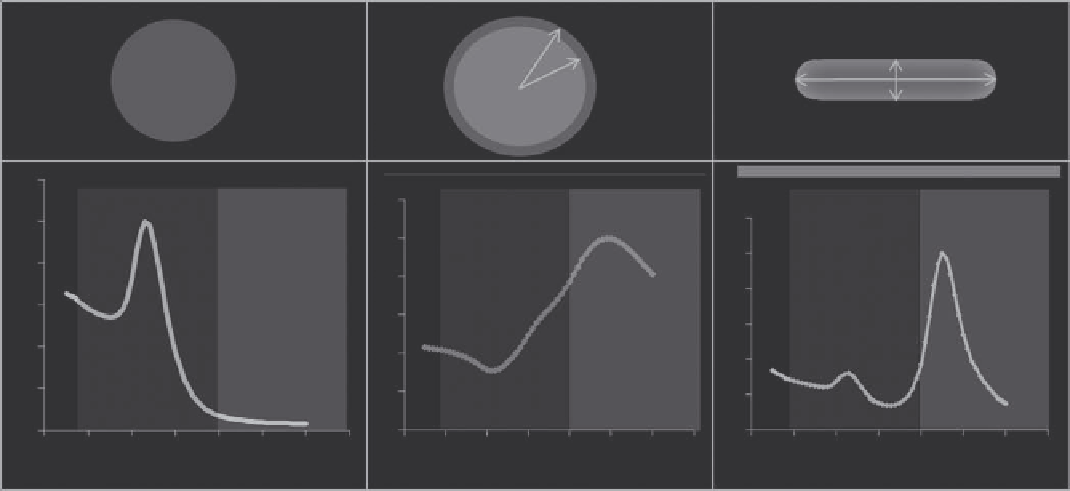Biomedical Engineering Reference
In-Depth Information
surface chemistry, and, of course, highly absorbing. Among the
various materials studied (Burda 2005), gold can satisfy all of
these criteria, particularly in NP form. The optical properties of
GNP, especially absorption that is related to heat generation for
thermal therapy, will be reviewed next.
of absorption and scattering. Table 18.2 gives a nonexclusive
list of recently developed GNPs with different shapes and opti-
cal properties including the surface plasmon resonance (SPR)
wavelength (λ
SPR
), absorption cross sections (
C
abs
), and the
ratio of absorption over total extinction (
C
abs
/
C
ext
). The listed
NPs all have SPR in NIR region except spherical GNP. The Au/
Si shell has the highest absorption cross section, but the size is
significantly larger than other particles. Gold nanorod and cage
have good absorption cross sections considering the relatively
small size. Comparing the ratio of absorption over extinction
(
C
abs
/
C
ext
), the low value for Au/Si shell indicates significant scat-
tering. In general, scattering increases as the GNP size increases
(Jain 2006, Bohren 1983). Comparing the absorption cross sec-
tion of these GNPs (10
3
~10
4
nm
2
) shows 5~6 orders of magni-
tude increase from traditional dyes like indocyanine green with
C
abs
= 1.66 × 10
−2
nm
2
at light wavelength of ~800 nm (Hirsch
2006, Jain 2007a). As discussed in the introduction, the absorp-
tion cross section is an important parameter for heat generation,
and the high value for GNP means much more heat can be gen-
erated under the same laser fluence.
Due to the importance of GNP optics for photothermal
therapy, accurate methods to theoretically predict and experi-
mentally measure the optical properties of GNPs are needed.
An important tool for prediction of the optical properties of a
given GNP is Maxwell's equation. While the general solution
of Maxwell's equation can be difficult, there are analytical solu-
tions for simple geometries such as sphere and shell (Bohren
1983, Link 2000). Note that size-dependent material proper-
ties need to be considered for particles less than 10 nm (Kreibig
1995). For more complex-shaped NPs, numerical methods
including boundary element method (BEM), discrete-dipole
approximation (DDA), and finite difference in the time domain
18.4.2 Optical properties of GNps
When light interacts with metallic particles, the electromagnetic
field of light drives the oscillation of free electrons in the metal.
When the frequency of light is approaching that of electron
oscillations, the amplitude of electron oscillation reaches the
maximum value, and this is called surface plasmon resonance
(SPR) (Jain 2007b). The energy of light is transferred to the metal
particle and then is either: (1) absorbed by the particle and dis-
sipated as heat; or (2) reemitted by the particle at the same fre-
quency (Rayleigh scattering) or at a shifted frequency (Raman
scattering) (Modest 2003). Both the absorption and scattering
is much stronger compared with traditional dyes because of the
SPR.
The GNP size and shape determine its optical properties
(Kelly 2003, Link 1999, Link 2000). Figure 18.3 shows the struc-
ture and the absorbance for three types of selected GNPs: gold
nanosphere, gold nanoshell, and gold nanorod. As one can see,
the SPR of the gold nanosphere is in the visible range (514-532
nm), while the SPR of the gold nanoshell and nanorod (longi-
tudinal) are tuned to the near infrared regime (700-900 nm),
which lies in the NIR window of tissue (Figure 18.1).
Often cross-sectional areas are used to describe NP optical
properties, and the amount of energy absorbed or scattered is
equal to the absorption or scattering cross section multiplied by
the laser fluence (
Q
nano
=
C
abs
I, E
sca
=
C
sca
I
). Extinction consists
R
2
D
R
1
L
R
1
= 60 nm
R
2
= 75 nm
D = 25 nm
L = 86 nm
D = 30 nm
VIS
NIR
VIS
NIR
VIS
NIR
300
400
500
600
700
800
900
1000
300
400
500
600
700
800
900
1000
300
400
500
600
700
800
900
1000
Wavelength (nm)
Wavelength (nm)
Wavelength (nm)
FIGURE 18.3
Optical properties of selected GNPs. Gold nanosphere, gold nanoshell, and gold nanorod with specific dimensions are shown.

